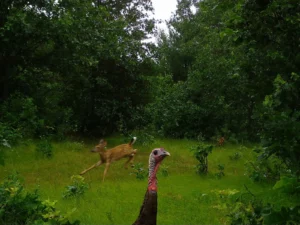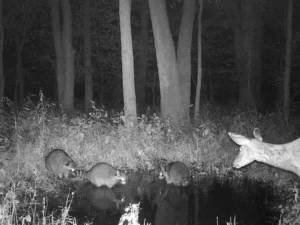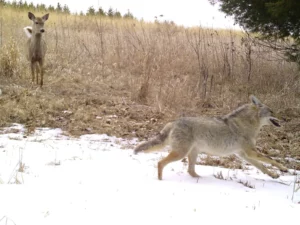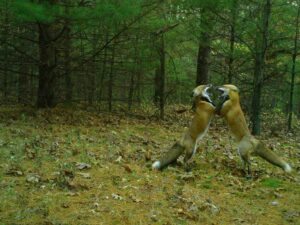Good morning.
Tuesday in Whitewater will see scattered showers with a high of 39. Sunrise is 7:21 AM and sunset 4:49 PM for 9h 28m 10s of daytime. The moon is a waning crescent with 25.4% of its visible disk illuminated.
The Whitewater Common Council meets at 6:30 PM.
On this day in 1945, Swedish diplomat Raoul Wallenberg is taken into Soviet custody while in Hungary; he is never publicly seen again.
- WI DNR Snapshot Wisconsin
- WI DNR Snapshot Wisconsin
- WI DNR Snapshot Wisconsin
- WI DNR Snapshot Wisconsin.
Emily Anthes reports Snarl, You’re on Candid Camera (‘Wildlife cameras in Wisconsin are capturing interspecies encounters — and providing evidence that human activity might make such meetings more likely’):
An animal’s fortunes, and the health of entire ecosystems, can hinge on these ephemeral encounters — or lucky non-encounters. “An animal must be at the right place, at the right time, to avoid predators, find food, reproduce successfully,” said Neil Gilbert, a postdoctoral researcher at Michigan State University.
In that way, the interactions between the animals in a given ecosystem are like a theatrical production, he said, adding, “For the production to be a success, each actor has to be onstage, in the right place, and they must act and deliver their lines at the right time.”
Now, a new study reveals how humans might unwittingly rewrite these ecological scripts, altering how the characters interact and fueling more interspecies encounters.
To conduct the study, Dr. Gilbert and his colleagues analyzed images captured by Snapshot Wisconsin, a citizen-science project run by the Wisconsin Department of Natural Resources. Since 2016, volunteers have deployed more than 2,000 wildlife cameras across the state, capturing tens of millions of images of Wisconsin’s fields, farms and forests — and the fauna that frequent them.
Wild animals of different species were more likely to lead overlapping lives — appearing at local camera sites in quicker succession — in human-altered landscapes, like farms, than in more undisturbed locations, such as national forests, scientists reported in PNAS last month.
….
The Wisconsin Department of Natural Resources created Snapshot Wisconsin in an effort to collect continuous, statewide data — at all hours of the day and during all seasons of the year — on local wild animal populations. It relies on an army of volunteer camera hosts to install, monitor and maintain wildlife cameras, on both public and private land across the state.
The cameras, which are triggered by motion and body heat, have captured a menagerie of animals going about their everyday lives: bald eagles scavenging in the snow, bear cubs climbing trees, a newborn fawn, a bevy of otters gamboling down a grassy trail. “It’s just so many otters,” said Jennifer Stenglein, a quantitative research scientist at the Wisconsin Department of Natural Resources and an author of the new study.
Beautiful and humbling: no art of ours reaches the beauty of the natural world.
Black hole twists star into ‘donut shape,’ Hubble discovery:





